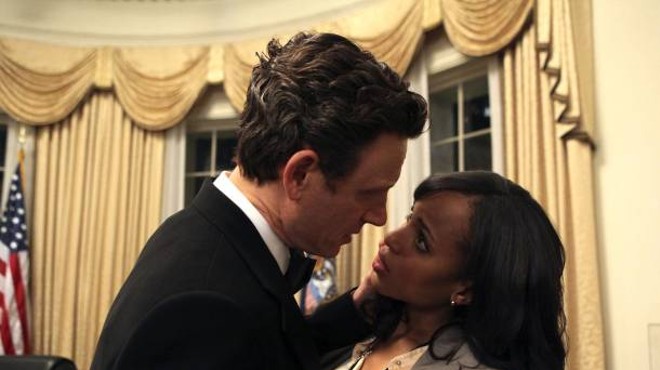Friday, October 3, 2014
Why flash-forwards don't work on "How to Get Away with Murder"—or any other show
How To Get Away With Murder, despite nearly every character acting the sneering villains the college comedy slackers would humble with a crazy prank, is shaping up to be one of the most enjoyable new shows. It’s got that shamelessly dramatic dialogue, monologues and plot-twists of the best guilty pleasures.
But almost immediately, it has a big flaw stuck into the very structure of the show: It gives us brief “flash-forwards” into a scene where the characters appear to be hurriedly covering up a murder.
The flash-forward gimmick is hardly a new one.
How To Get Away With Murder’s device is an almost exact ripoff of one of the worst parts of another legal thriller, Damages. That show parceled out the narrative in the present with brief glimpses of the future — horrible things happening to an ambitious legal mind due to her involvement with a take-no-prisoners female mentor. (How To Get Away With Murder distinguishes itself by giving us glimpses of horrible things happening to multiple ambitious legal minds due to their involvement with a take-no-prisoners female mentor.)
It’s a device that’s been used in shows like Lost, Breaking Bad, and How I Met Your Mother. And it hurt every one of them.
Heck, there was even a television show called FlashForward that made this the entire premise – that everyone on earth sees a vision of themselves from the future — and it buckled and collapsed under the strain almost instantly.
The temptation for a writer to put a flash-forward in a pilot is understandable. It’s a promise: This is how crazy things will get. It’s supposed to be like your friend saying, "Hey, stick with it, the show gets really good around episode 22."
But flash-forwards ultimately are more like skeevy payday loan operations: They borrow interesting narrative from the future to spend in the present. And the interest rates are downright predatory.
To expand on that: One of the most enjoyable parts of watching TV is asking two fundamental questions: 1) What is happening now? 2) What will happen next? Yet a flashforward spoils the answer to #2 and makes the answer to #1 feel irrelevant. Both questions are replaced with “How does the story get from A to B?” (Or A to Z.) That’s not a mystery or an adventure. That’s a MapQuest printout.
A flashback is problematic because it kills narrative momentum by taking us out of the present. Why would I care about what happened six months ago? I want to know what’s happening now. But flash-forwards turn almost the entire show into one giant flashback. It cheapens what’s happening in the present by showing us the consequences.
Sometimes those flash-forwards are lies: They use unreliable narration, deceptive editing or trick camera angles to pretend something will happen when it won’t. But that breaks the trust between viewer and show, which greatly harms future seasons.
How I Met Your Mother had to bend over backwards to try to fulfill the many promises the show had made about the future and still surprise the audience. The result had the fans angry and revolting.
Other times, the flash-forwards are the exact truth, creating expectations difficult to fulfill: The reveal of Lost’s flash-forwards made for an iconic moment, for example, but the story struggled to fill in the gaps in a logical, satisfying way.
Mind you: A flash-forward can work brilliantly in long-form non-fiction journalism. Even novels, to a certain extent, can benefit from this sort of structure.
But a serialized TV drama is not a novel or long-form non-fiction. It is a serialized TV drama – and one of its biggest strengths should be its agility. The story is a living, breathing thing that can veer off in wonderfully surprising directions. A plotline that’s not working can be excised, a character can be killed off, a more interesting thread can be pulled. Most of the time, it’s not the vision of one mind, it’s a room of writers. Epiphany can strike and transform a show at any time.
Actors quit. Actors die. Ratings fall. Writers change their minds.
In some cases, a flash-forward can work within a single episode. A Breaking Bad episode opens with the serial image of bullet shells on the hood of a car, bouncing as hydraulics send the car up-and-down. It’s a tease more than a spoiler. It’s a poetic image that hooks and intrigues.
But Breaking Bad stumbled when it tried to create season-long flash-forwards. It famously began its 5th season with a bearded Walter White opening up his trunk to reveal a massive machine gun. At the time the writers had no idea what it would be used for.
The result was the worst of both worlds: The constraints of a perfectly planned show and the lack of foresight of an improvised one. Partly as a consequence, the finale to one of TV’s best shows of all time was, ultimately, disappointing.
How To Get Away With Murder doesn’t aspire to Breaking Bad’s greatness. But it wants to be surprising, fun and fast-paced – and flash-forwards make every one of those goals more difficult.























